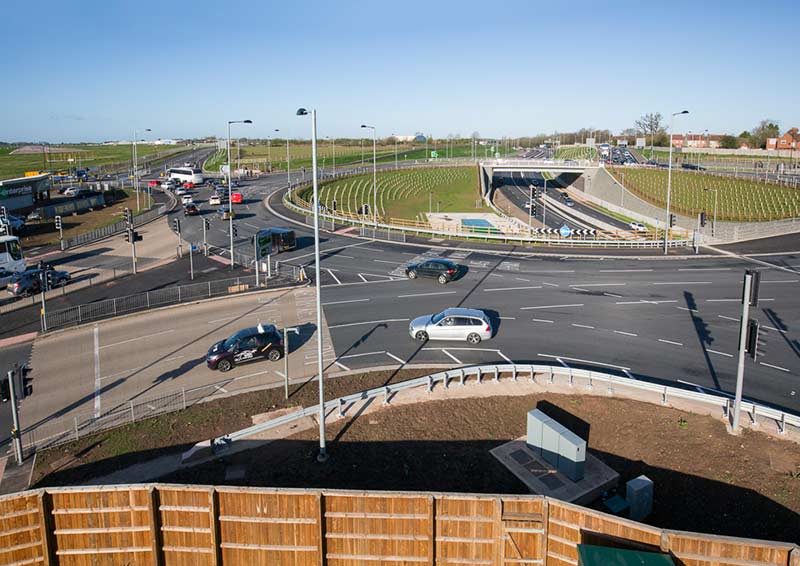Five years of road investment strategy

|
| As 2019 draws to a close, President’s Future Leader Louise Hetherington looks back at the government’s Road Investment Strategy introduced in 2014. |
Contents |
[edit] Introduction
RIS1. Another abbreviation in an industry full of three-letter acronyms, shortening everything from project names through to technical terms and even industrial strategies. And RIS1 is one of the latter, standing for 'Road Investment Strategy'. Published in 2014 by UK Government, the strategy outlined a long-term programme for major roads; a different approach to prior short-term planning. And as the end of the 2015/16 to 2019/20 road period draws to a close, the ICE in association with a group of contractors and consultants, reviewed the successes and shortfalls of the strategy. Hosted by ICE President, Paul Sheffield, the roundtable event saw a lively discussion with feedback being provided to help shape future investment in the strategic road network (SRN). As a President’s Future Leader, Louise Hetherington was able to attend the roundtable and this blog summarises the outcomes from the discussions.
[edit] Why was RIS1 published and what did it focus on?
RIS1 outlined how the government could revolutionise the SRN over the coming decades, focussing on the 5 C’s; certainty, connectivity, capacity, condition and construction. The long-term nature of the strategy strived to enable certainty in the funding streams to facilitate delivery and drive efficiencies. By improving major trunk roads such as the A19 and A303, the strategy aimed to transform connectivity. With Smart Motorways and other schemes, planned capacity was proposed to increase with an additional 1,300 miles of lanes while condition was also high on the agenda to ensure major roads in England are fit for purpose. And finally, construction. The key element for ICE stakeholders and within RIS1, £5 billion was set aside for 50 schemes to enable construction to connect new developments.
[edit] What were the successes of the strategy?
This strategy led to the change from the Highways Agency to Highways England. The move further from government enabled more connectivity with regulatory bodies and allowed the entity to become more customer focussed. Ultimately, this change was a success, with Highways England growing as a corporation. Other successes noted by those around the table included the benefit of secured funding. The certainty that the funds would be available has allowed Highways England to grow and has prevented the stop-start style of road construction from happening. Furthermore, the certainty of the long-term strategy has enabled companies right across the supply chain to plan better, with a clear pipeline for incoming works.
While there was still flexibility in the delivery of RIS1 projects, the proposed projects have gone ahead, and this is a significant step forward for contractors and consultancies alike. Additionally, the designated funds allowed the industry to collaborate, innovate and ultimately improve processes. A major success is the A14, which recently opened its first section, not only on budget, but a year ahead of schedule. This is all due to the collaboration and innovation of the teams involved. Further innovations include working towards better air quality and RIS1 is applauded for what it has done to drive 'digital' within road development.
[edit] What have we learnt through the process?
However, while there have been many successes, there have also been shortfalls which can help shape future road investment.
In 2017, the National Audit Office published a report outlining whether Highways England and DfT really could deliver on value for money. This was a key focus of part of the discussion as attendees debated what 'value for money' really meant, and highlighted how striving for value only in an economic sense often meant settling on the cheapest solution, thus not ensuring improved efficiency and squeezing profit margins. Work needs to be done in the procurement of the works to ensure true value for money can be achieved, including up-front spending to ensure alliances are formed and innovations are effectively leveraged. This will ultimately help drive efficiency in the industry.
Finally, a large part of the debate focussed on the disconnect between those setting the budget and the people delivering the projects. A fundamental change for future strategies should see discussions occurring prior to budgets being set, to ensure the numbers are feasible, innovation can be supported, and efficiencies discovered.
[edit] What’s next?
So, where does this leave those developing the next road investment strategy (RIS2)? It was widely agreed the time commitment to develop RIS1 introduced some risk, however it was largely accepted that the strategy has been a success. It was noted that the short time span resulted in increased flexibility which may not be possible in RIS2 due to the more in-depth planning which has occurred. However, this is not currently perceived as a problem as the planning should counterbalance some of the need for flexibility.
Overall RIS1 provided a new direction for long-term investment in the SRN, with a number of successes to repeat for RIS2 and a series of lessons to be learnt in parallel.
[edit] About this article
This article was written by Louise Hetherington MEng GMICE, Structural Engineer / President’s Future Leader. It previously appeared on the website of the Institution of Civil Engineers (ICE) in December 2019 titled 'Road investment strategy - five years on' and can be accessed HERE.
Other articles by the ICE on Designing Buildings Wiki can be accessed HERE.
[edit] Related articles on Designing Buildings Wiki
- Achieving sustainable roads funding in England.
- Cutting road congestion.
- Delivering the second road investment strategy RIS2.
- Digital Roads 2025.
- Highway authority.
- Highways England.
- How to keep roads future-proof.
- Road development process.
- Roads revolution.
- Roads.
- Types of road and street.
[edit] External references
Featured articles and news
Key points for construction at a glance with industry reactions.
Functionality, visibility and sustainability
The simpler approach to specification.
Architects, architecture, buildings, and inspiration in film
The close ties between makers and the movies, with our long list of suggested viewing.
SELECT three-point plan for action issued to MSPs
Call for Scottish regulation, green skills and recognition of electrotechnical industry as part of a manifesto for Scottish Parliamentary elections.
UCEM becomes the University of the Built Environment
Major milestone in its 106-year history, follows recent merger with London School of Architecture (LSE).
Professional practical experience for Architects in training
The long process to transform the nature of education and professional practical experience in the Architecture profession following recent reports.
A people-first approach to retrofit
Moving away from the destructive paradigm of fabric-first.
International Electrician Day, 10 June 2025
Celebrating the role of electrical engineers from André-Marie Amperè, today and for the future.
New guide for clients launched at Houses of Parliament
'There has never been a more important time for clients to step up and ...ask the right questions'
The impact of recycled slate tiles
Innovation across the decades.
EPC changes for existing buildings
Changes and their context as the new RdSAP methodology comes into use from 15 June.
Skills England publishes Sector skills needs assessments
Priority areas relating to the built environment highlighted and described in brief.
BSRIA HVAC Market Watch - May 2025 Edition
Heat Pump Market Outlook: Policy, Performance & Refrigerant Trends for 2025–2028.
Committing to EDI in construction with CIOB
Built Environment professional bodies deepen commitment to EDI with two new signatories: CIAT and CICES.
Government Grenfell progress report at a glance
Line by line recomendation overview, with links to more details.
An engaging and lively review of his professional life.
Sustainable heating for listed buildings
A problem that needs to be approached intelligently.
50th Golden anniversary ECA Edmundson apprentice award
Deadline for entries has been extended to Friday 27 June, so don't miss out!
CIAT at the London Festival of Architecture
Designing for Everyone: Breaking Barriers in Inclusive Architecture.
Mixed reactions to apprenticeship and skills reform 2025
A 'welcome shift' for some and a 'backwards step' for others.



























